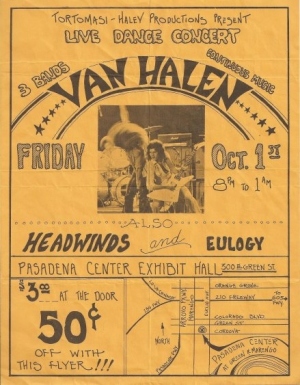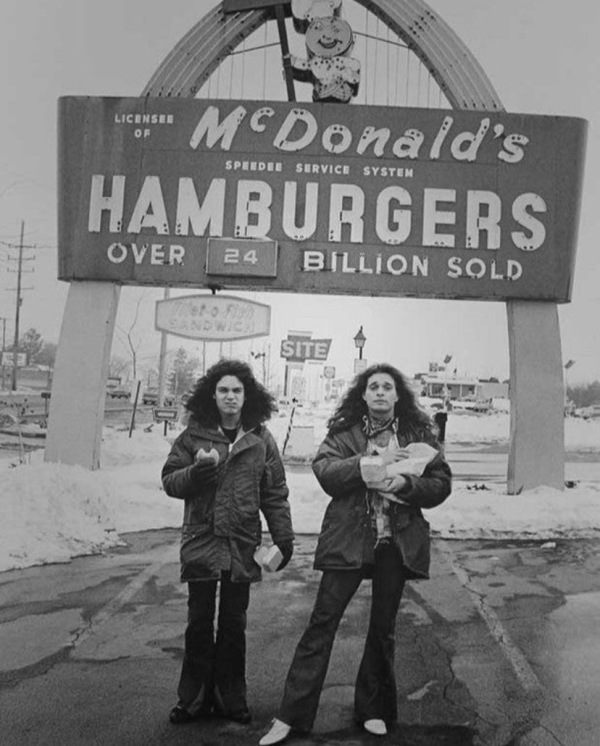 BY BILL HANGLEY JR. Eddie Van Halen dies, and the word that comes to mind is “joy.” That’s m’lady’s word for his music, and she’s right. She’s a huge fan, and many are the nights we’ve spent with a bottle of wine and the pounding rubbery cartoon violence of 1984. What Eddie embodied, she always said, was “pure, male joy.” Not the meathead glower of your modern vomit-vocal metal. Not the prosthetic-penis fakery of your day-glo hair bands. But instead, from Eddie Van Halen, godfather to them all, true joy; the jolly roar of a chainsaw crossed with an ice cream truck. Open, generous, dressed for frights but promising delights. For all the cartoonishly-crass fist-shaking, pelvis-pumping sizzle of Van Halen’s best work, it was always as welcoming as an amusement park at the end of the pier.
BY BILL HANGLEY JR. Eddie Van Halen dies, and the word that comes to mind is “joy.” That’s m’lady’s word for his music, and she’s right. She’s a huge fan, and many are the nights we’ve spent with a bottle of wine and the pounding rubbery cartoon violence of 1984. What Eddie embodied, she always said, was “pure, male joy.” Not the meathead glower of your modern vomit-vocal metal. Not the prosthetic-penis fakery of your day-glo hair bands. But instead, from Eddie Van Halen, godfather to them all, true joy; the jolly roar of a chainsaw crossed with an ice cream truck. Open, generous, dressed for frights but promising delights. For all the cartoonishly-crass fist-shaking, pelvis-pumping sizzle of Van Halen’s best work, it was always as welcoming as an amusement park at the end of the pier.
Singer David Lee Roth was the carnival barker. Drummer Alex Van Halen powered the roller coaster. Bassist Michael Anthony propped up the facades and spun the cotton-candy background vocals.
And Eddie?
Eddie was the thousand-foot candy-colored plastic slide that dropped you from ninety feet up, spun you around sixteen times, tossed you into the air, and finally dumped you into the Pacific with a massive, joyous splash.
This was a great pop craftsman who launched flares of true genius. Not just any Dutch kid could take one of Michael Jackson’s best songs and – in Jackson’s own words – “not just blaze a solo … but make it better.” Eddie Van Halen didn’t just play on “Beat It,” he rearranged the tune in ten minutes in order to ensure that when it came cranking out of somebody’s car stereo, they’d have no choice but to stomp the gas. Resistance was futile.
The resulting rush was as American as the 20th century. Wanna feel good? Hit play on Van Halen and hit the road. Make speed. Move, baby. At its best, Van Halen was your car, no problems, and an open highway. Was there anywhere to go? Who cares? Let’s go anyway! Van Halen was the Beach Boys of the shopping mall age, and Eddie was the band’s Brian Wilson.
And now Van Halen is truly over, and with it, a chapter of late 20th Century American history.
Because in Eddie and Van Halen we can see the beginning and end of a very particular American time and place: the sprawling postwar California suburbs that are smoldering as you read this. All great bands need a great scene, and for Van Halen the scene was the massive, folks-away cul-de-sac keg parties of the 1970s. The text to consult for a full, beer-soaked account is Van Halen Rising, by Greg Renoff, a tremendously entertaining band bio of the best variety: written by a fan, with a fan’s commitment to accuracy and detail, and focused entirely on the early years when the band was coming together and fighting for success.
Renoff’s book reveals the perfect party Petri dish of Pasadena: an endless sprawl of yards, pools and rumpus rooms, stuffed with Boomers’ kids, with money and cars and nowhere to go but to each others’ houses whenever somebody’s parents went away. California’s drinking age was already 21, but people acted as if it was still 18. High school meant weed, rock, beer and birth control. The five-buck-a-head backyard kegger was a summer standard.
And what those parties needed was bands. To play. For hours. And hours. And hours and hours and hours.
Eddie was a perfect match. Van Halen Rising describes an absolutely typical guitar nerd: weirdo loner teen, shacked up for hours at a time, piecing together solos from the stadium rock of the day. Clapton. Page. Alvin Lee’s “Going Home.” California’s first sight of Eddie Van Halen was of a kid staring at his sneakers playing note-for-note versions of what they already knew from the radio.
It took David Lee Roth – himself an extraordinary California story, a singer who couldn’t sing but who kept Eddie from devolving into just another self-indulgent 70s guitardroid – to shape the band into what became Van Halen. Roth’s unbridled ambition got Eddie out of the suburbs and into the LA clubs that made them both stars. Without Roth, Eddie might have spent his life basements, unraveling Steve Vai solos under the black light headphones and wondering if he could have been somebody.
But he got out. Van Halen left the keg parties behind just in time. Van Halen Rising describes a scene that grew well out of hand: cul-de-sacs lined with hundreds of cars, impromptu parties turning into massive drunken mini-festivals. Suddenly American teenagers had too much time and money and horsepower and real estate for their own good, and America had to clamp down.
So by the time Van Halen started hitting the pop charts, Carter had been replaced by Reagan, the national drinking age was officially 21, the sexual revolution had met the Moral Majority, and surfing safaris had been replaced by shopping safaris. The beach was out; the mall was in. The Beach Boys were out; Banana Republic was in.
Van Halen helped carry America across that great divide with its rock and roll intact. The band packaged the sprawling, raucous spirit of seventies rock into the kind of plastic container appropriate for sale at the Galleria. They shrink-wrapped all of “In A Gadda Da Vida” seventeen-minute madness into blistering three-minute singles like “You Really Got Me” and “Panama.”
And they did it with pleasure. The invited everyone in. The responses to Eddie’s death from people of all walks of musical life tell you how well they succeeded. Stroll down the boardwalk and there’s a lot of crap for sale, but when you pass the Van Halen booth, who could resist going in?
Hardly anybody, that’s who. Irresistible: that was Van Halen at its best.
And that might sound simple. But look at how few can do what he did – especially guitarists. One of the easiest things to do on guitar is act scary, and by the end of the ’70s there were a lot of wannabe-scary guitarists around. It’s not hard. Lots of people can make guitars scream or groan or roar like a chainsaw falling down a flight of stairs. Sometimes all you need to do is push a button or stomp a pedal.
But precious few players can make a guitar laugh. No pedal does that. Off the top of my head, the very short list includes Joe Walsh, Doc Watson, and John Scofield. Bill Frisell can squeeze out a wry chuckle. Jerry Garcia could make it giggle like it was baked.
But Eddie Van Halen could make a guitar open its mouth wide and laugh out loud, and when he did, the world laughed along.
These days there’s not much to laugh about. The suburbs are burning. The malls are closed. Kids party on Zoom. That warm California sun will kill you. Five bucks barely buys a cup of coffee, let alone all you can drink at an all-day California pool party.
But somewhere there’s a kid in a bedroom, headphones on, a guitar in hand, a sound in mind, who will change music again. It’s not working yet. It still sounds just like somebody else’s guitar. But when you do a little like this, and then a little like that, and then you press that like that – wow. That’s cool! That feels like…something.
RIP, Eddie Van Halen.

